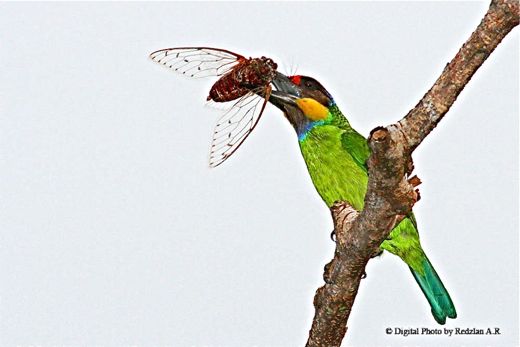The food of the Gold-whiskered Barbet (Megalaima chrysopogon) has been reported to be largely fruits like figs and berries (Short & Horne, 2002; Wells, 1999). The bird has also been reported to take insects like termites. Cicada as a food is not well known, that is, until now (above).
On the evening of 5th March 2008, Dr Redzlan Abdul Rahman documented a Gold-whiskered Barbet catching a cicada. His neighbourhood in Raub, in the Peninsular Malaysian state of Pahang, is an area rich in bird life. He need not leave his home to document bird behaviour. For the last few years the birds visited and provided him with numerous photo opportunities.
When he noticed a Gold-whiskered Barbet perched on a branch outside his home, all he had to do was rushed indoors for his camera, point at the barbet and made the necessary shots. His series of images shown here showcase the stages of subduing this large insect prior to eating it.
Once clamped firmly in its bill, the barbet swiped the cicada many times against the tree branch in an effort to kill it (above: top l-r, bottom l-r). It was quite an effort. The tough, large wings of the insect did not break as a result of the bashing.
And once subdued, the barbet tried to swallow the cicada. The insect was a little too large for the bird and the latter had difficulties trying to swallow it (below). In manipulating the cicada further, the bird nearly lost its hold on the insect. Realising its problems, the barbet flew off with its prize to either feast elsewhere, to offer it to its mate or even to feed its chicks. The entire episode lasted less than a minute.
Cicadas are rather large insects that make their presence heard only when they sing their high-pitch mating song. This song is made only by the males, the females remaining silent all the time. Even with this high pitch buzz, it is not always easy to spot the insects as they stop singing when approached.
The loud group singing of cicadas can deter birds, as it is said to hurt the birds’ ears and thus interfere with their communication.
Dr Redzlan’s neighbourhood obviously attracts plenty of cicadas. The presence of these insects, in turn, attract different species of birds. He posted an earlier account of a Black-naped Oriole (Oriolus chinensis) catching a cicada.
References:
1. Short, L. L. & Horne, J. F. M. (2002). Family Capitonidae (Barbets). Pp. 140-219 in: del Hoyo, J., Elliott, A. & Sargatal, J. eds. Handbook of the birds of the world. Vol. 7. Jacamars to Woodpeckers. Barcelona: Lynx Editions.
2. Wells, D.R. (1999). The birds of the Thai-Malay Peninsular. Vol. I, Non-passerines. Academic Press, London.






















2 Responses
I didn’t realise the Cicada was so big or the Barbet was so small. Amazing picture.
The barbet is not all that small.